24 – Manhauling Again - The 59 Expedition
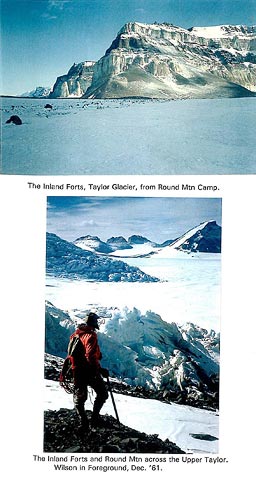 My doctorate work on the chemistry of the Ferrar Dolerites went slowly. In 57-58 I had collected enthusiastically from great massive intrusions and their chemistry was extreme but a puzzle remained. Could a quite small sills or dikes intruded as hot liquid basaltic magma end up with the zones of heavy, pyroxene minerals with the high concentrations of Mg, Cr, Co, Ni etc that I had found simply by the crystals sinking down towards the bottom of the sill, and with the last little percent or so giving the very potassic granophyres? Or were the pyroxenes concentrated into an almost solid crystal mush before intrusion, somewhere down at the base of the crust? To decide I had to find a closed magma chamber or sill with top and bottom and every inch of the middle, not some great mass with no roof and no apparent floor. Quite natural processes had allowed a simple basalt to end up with crystal accumulations with at least ten times as much of the basic elements as was in the original basalt and with small patches of residual liquid with from 5 to 20 times the potash, Rb, Ba, Uranium, thorium etc. and we have to understand those processes. Civilisation stands on a structure of metals and God or Providence, call it what you will, gave us a hundred elements to manipulate. Back to the Antarctic I had to go!. But first to Wellington.
My doctorate work on the chemistry of the Ferrar Dolerites went slowly. In 57-58 I had collected enthusiastically from great massive intrusions and their chemistry was extreme but a puzzle remained. Could a quite small sills or dikes intruded as hot liquid basaltic magma end up with the zones of heavy, pyroxene minerals with the high concentrations of Mg, Cr, Co, Ni etc that I had found simply by the crystals sinking down towards the bottom of the sill, and with the last little percent or so giving the very potassic granophyres? Or were the pyroxenes concentrated into an almost solid crystal mush before intrusion, somewhere down at the base of the crust? To decide I had to find a closed magma chamber or sill with top and bottom and every inch of the middle, not some great mass with no roof and no apparent floor. Quite natural processes had allowed a simple basalt to end up with crystal accumulations with at least ten times as much of the basic elements as was in the original basalt and with small patches of residual liquid with from 5 to 20 times the potash, Rb, Ba, Uranium, thorium etc. and we have to understand those processes. Civilisation stands on a structure of metals and God or Providence, call it what you will, gave us a hundred elements to manipulate. Back to the Antarctic I had to go!. But first to Wellington.
The bureaucrats looked me over with all the warmth and sympathy of bankers looking over an over-leveraged bankrupt,
“What do you think you could do?” they said with sarcasm not even thinly concealed, “You’ve had frostbite, you would be a liability.” And so on.
Of course I was more than a little embarrassment to them as they had exsolved themselves of all blame in sending us into a dangerous area by loudly claiming “It was all the fault of the Party Leader! He took them into places they were never meant to go!”
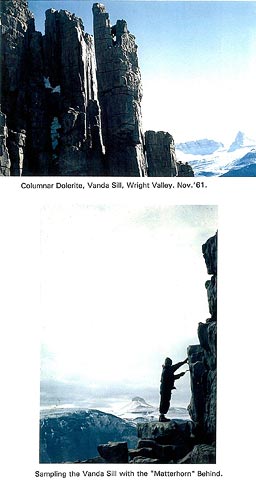 No use in pointing out I was onto one of the most important pieces of research that could be done in the whole petrological world. I was given a medical examination and a medical report which intimated I should be in a home for the aged and infirm, not without some justification as I could still only stand for half an hour or so at a time, but all I wanted was to go back up the old Ferrar-Taylor and do some really detailed collecting. I knew what I could do, I might limp along and be slow, but I could do it.
No use in pointing out I was onto one of the most important pieces of research that could be done in the whole petrological world. I was given a medical examination and a medical report which intimated I should be in a home for the aged and infirm, not without some justification as I could still only stand for half an hour or so at a time, but all I wanted was to go back up the old Ferrar-Taylor and do some really detailed collecting. I knew what I could do, I might limp along and be slow, but I could do it.
I didn’t need much equipment apart from a sledge and a tent, a roomful of gear, sleeping bags, packs, crampons, ropes, parkas, anoraks, leftover from other expeditions would take care of my small party, if I could put one together. Only a few years ago twenty young men would have been glued to my side at the rumour of an Expedition, but who was available now? Murray Robb, that greatest of men, was dead by this time, killed in a stupid car accident while blinded by the light of an approaching train. He had been more than a right arm, more than an oaken staff, while usually he looked to me for leadership, when I put a foot wrong, he let me know. Once we were both given a ride back from Lower Hutt to Wellington by a middle aged woman who was a devout Christian and held some position in the Church. Like many of the kind her faith was built on faith not knowledge or reason and I passed the time away pointing out the inconsistencies. I should have been warned by the silence in the back.
“That was a bloody awful thing to do!” said Robb in that steely tone when we alighted.
“Why?” I said, startled.
“That poor damn woman, what else does she have? Of course she can’t stand up to you in an argument, but all you did was make her miserable!” As usual he was right and I have shown a little more tolerance towards other’s beliefs from that moment, I hope. Many others had gone, Cohn Todd that I once climbed Cook with had died in a motorcycle accident, John Robertson, that very fine and much admired young man, in an avalanche in a vain rescue attempt, Dave Heron in an avalanche in the Alps, Keith Scott lost at sea in a Foveaux Strait storm, Jim Glascow knocked off the summit of Cook. Cohn Knox had the honour of having recorded in a single Alpine Club Journal accounts of his Oxford Expedition to Spitzbergen, to East Greenland, his climbs in the Alps and his obituary. I was beginning to feel old and alone and even a touch guilty that I was unworthy enough to have been spared.
 I was invited to an Antarctic Society evening held somewhere high on a hill above the Terrace. A young woman, a friend of Robb’s one-time fiancee took me. At the close of the evening I did one of those brilliant things, refused a taxi and announced I would walk home with her. I actually made it and collapsed on the floor of her hallway, where to her acute embarrassment I had to remain till next morning, short of getting an ambulance, with a raincoat for a blanket. I finished the doctorate work, rather unsatisfactorily, on the material I had but there were still problems unsolved.
I was invited to an Antarctic Society evening held somewhere high on a hill above the Terrace. A young woman, a friend of Robb’s one-time fiancee took me. At the close of the evening I did one of those brilliant things, refused a taxi and announced I would walk home with her. I actually made it and collapsed on the floor of her hallway, where to her acute embarrassment I had to remain till next morning, short of getting an ambulance, with a raincoat for a blanket. I finished the doctorate work, rather unsatisfactorily, on the material I had but there were still problems unsolved.
Well, no one in New Zealand ever was very helpful, but there were other resources and I wrote to the National Science Foundation in Washington, DC, putting up a proposal. Dr Phil Smith came to see me, and not for the first time, American scientists grasped what had to be done without throwing a lot of obstacles in the way.
“We like your project” he said. “You will get all the helo support you need and Base Support at McMurdo as well as financial support for two years. But we don’t like the University you have nominated in the States, we suggest you pick another one.” My professor suggested Australian National University in Canberra to my surprise. It was in fact the finest research centre in the Earth Sciences in the world at the time due to a very sensible policy decided on by the Australian Government. Instead of spreading financial resources thinly over six provinces, it was concentrated on one location, Canberra. If a West Australian wished to do advanced research, the advice was, at that time, “Buy an air ticket to Canberra!” Now this has changed and a dozen rival research centres compete for funds and Australia has lost the pre-eminence it once had.
However, the U.S. Navy still insisted on a Medical, but the doctor knew nothing about my past. I kept my stockings on throughout and he never noticed the frostbitten feet or odd-length toes! But he did tap my lateral bulge where a nerve is severed round the middle and I waiting without breathing.
“Drink a bit, do you? “ he said at last!
Back south again, in the Connie, (ie, Super Constellation, a four engined long thin transport plane). A young American sat next to me.
“Have you been down before ?“
“Oh, three times!” His eyes widened.
“So you are an O.A.E.?”
“What on earth is one of those ?“
“An Old Antarctic Explorer!”
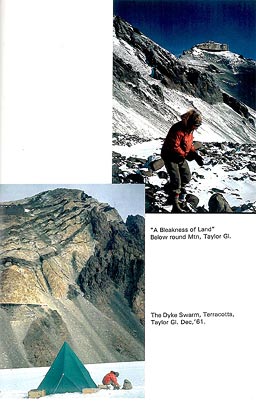 I had one companion, James Wilson. Jim is a renowned mountaineer from Canterbury and a noted expedition man. The Wilsons are of course a sept of Clan Gunn and we had a good deal in common. He was one of those ever-cheerful, ever resourceful people that make a difficult expedition to remote country seem so much simpler than a garden party.
I had one companion, James Wilson. Jim is a renowned mountaineer from Canterbury and a noted expedition man. The Wilsons are of course a sept of Clan Gunn and we had a good deal in common. He was one of those ever-cheerful, ever resourceful people that make a difficult expedition to remote country seem so much simpler than a garden party.
At McMurdo the American Base had expanded, instead of the simple two lines of huts there some large buildings including the U.S.A.R.P. warehouse which boasted an office on the mezzanine floor with a large double glazed picture window with a view of Lister and the Royal Society Range. This was the year it was found that men who had overwintered built up a society and language of their own and very much resented the influx of new men the following November. The U.S. Navy had a ruthless solution, every man who had wintered was shipped home within a week!
On the slopes of Observation Hill they were building, of all things, a nuclear power station because of the high fuel costs. This I had to see and I was shown over, wearing protective clothing, to peer into the “Swimming Pool” where the radioactive core was submerged. When I came out a detector was run over me and the geiger clattered hysterically.
“My God!” they said, “He’s picked up some contamination, into the shower with him.” But then a saner soul said, “Check his watch first!” To think a simple wrist-watch with numerals that glow in the dark has enough radio-activity to panic a nuclear power station!
It never in fact worked due to the build-up of bubbles of nascent hydrogen on the reactor elements causing them to be insulated from the water and so to overheat. The boron rods would then be automatically dropped into the pile to thermalise the neutrons and the generator would cool. Why this occurred at McMurdo and not elsewhere was never explained. So to this day diesel smoke continues to blacken the snow.
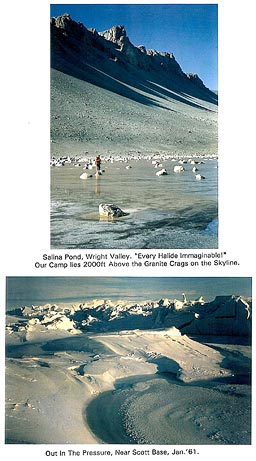 We soon had our gear sorted out and we were away for a month in the Ferrar Taylor area, purring over the blue Sound in a very improved type of chopper. I pointed a finger at a small dry valley in the upper Taylor and we were dropped near Round Mountain where we put up the green pyramid tent on a snow patch and cached most of our gear.
We soon had our gear sorted out and we were away for a month in the Ferrar Taylor area, purring over the blue Sound in a very improved type of chopper. I pointed a finger at a small dry valley in the upper Taylor and we were dropped near Round Mountain where we put up the green pyramid tent on a snow patch and cached most of our gear.
Then we back-packed through a pass over into the Wright Valley and camped in our little green Meade tent on a snowpatch on the very edge of the towering bluffs above Sauna Pond with Lake Vanda shimmering a little to the north-east and with old friend Shapeless only miles to the northwest. It was rather
like the North Rim of the Grand Canyon and one could sit on a rock, perched above the great gorge while the eyes roamed from Mt Newall that we climbed in the spring of ‘57 to Mount Mahony and even Mount Gran and old Tent Peak far north, to our Christmas Eve camp above Wright’s Cascades.
I had that warm feeling of being home again and stood on a massive glacial erratic perched all those thousands of feet above the valley and sang.
“Ah-ha-ha-mazing Grace, How kind thou art”! I warbled.
“What the hell is that noise?” cried a voice from within the tent.
“Too Hoo Save a-ha soul liike meeee!”
A body erupted out of the tent.
“By heaven above”, said James, genuinely baffled, “I thought a seal must have got up here!”
The shoulders of the Valley are formed by the thousand-foot thick Lake Vanda Sill and this we wanted to sample. Basalt columns tower hundreds of feet, and Wilson flung himself at one, determined to climb it, scrabbling in vain for the tiniest fingerhold but its defences were too strong and he slid and fell. Wilson taped heights below the upper contact as I hammered off fresh samples, numbered them, drew sketches of them (for positive identification) and put them in bags.
Near the top we found layers of coarse-grained, iron, soda and potash-rich granophyre, further down feldspathic dolerite, then a sudden transition into a rock dense with green orthopyroxene, the layer with most of the Mg, Cr, Ni, Co, etc. It was exactly what I had wanted and we had found it on our first sill.
Finally, one day, we went down, down into the valley, down the Vanda Sill, over thousands of feet of scree, down red and pink granite, collected the Basement Sill near the Valley floor and dying of thirst, went out to the Pond and scooped up a handful of water. The oilyness should have warned me, it was almost pure liquid salt, not just simple sodium chlorides but every halide and nitrate imaginable. We climbed about 5000 feet back up to the camp making gagging noises and lost no time melting fresh snow! So the Pond became “Sauna Pond”!
 Skiffs of snow swept the hills and corries and etched the permafrost as we packed back up the long hanging valley littered with old glacial debris and sandstone blocks and through the pass, but with iceaxes tucked under our arms we moved swiftly on, two tiny figures in the vastness of land and I felt a glow of contentment at merely living.
Skiffs of snow swept the hills and corries and etched the permafrost as we packed back up the long hanging valley littered with old glacial debris and sandstone blocks and through the pass, but with iceaxes tucked under our arms we moved swiftly on, two tiny figures in the vastness of land and I felt a glow of contentment at merely living.
“I should have died”, I thought. “And all this is free!” Perhaps never have I felt so content merely to be alive, though in all truth it was a desolate enough spot to generate such feeling.
My feet were a little tender, and the numb patch round the middle sometimes made getting in through tent sleeves awkward, but there were moments I could forget that I was no longer the man I had been. Wilson unobtrusively did more than his share of the difficult things and I leaned somewhat on his strength.
The following day was fine and we climbed Round Mountain, a yellow pile of sandstone and chocolate dolerite and later moved up the valley to North-west Mountain. A foot went down a crevasse and my heart stopped, in fact it was many years before a little of the old insouciance returned. A few days later we packed the pyramid and gear on our manhauling sled to traverse over the same stretch of glacier on which Smith had found the magnificent ‘ole seven years before. We leaned on the sled which was stacked at least five feet high and stared at each other.
“Why aren’t you a dog-team, Wilson?” I said bitterly.
There came a buzzing in the sky and a helo windmilled in. We had had radio problems and a new one had been sent. We looked at each other.
“Look”, said I to the pilot, “I don’t suppose you could give us a lift about ten miles over the glacier could you?”
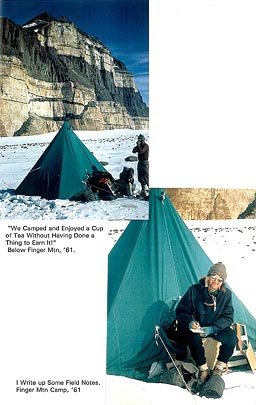 “Why not?” said the pilot. And half an our later we stretched out on our bags under the yellow layered cliffs of Finger Mountain to a truly memorable cup of tea without having done a thing to have earned it. Two beautiful dolerite sills crossed each other behind the tent, (see pix) and soon we were off to climb Finger Mountain behind. It was not so impossible as it looks as around the corner a mile away the slope to the top is much gentler.
“Why not?” said the pilot. And half an our later we stretched out on our bags under the yellow layered cliffs of Finger Mountain to a truly memorable cup of tea without having done a thing to have earned it. Two beautiful dolerite sills crossed each other behind the tent, (see pix) and soon we were off to climb Finger Mountain behind. It was not so impossible as it looks as around the corner a mile away the slope to the top is much gentler.
It was a simple little expedition. With only two men there were no complications, we sampled many sills, and, often being high on the hills, climbed widely and only on Finger Mountain did we find we had been forestalled. Flo Ugolini, an Italian pedologist who had been on K2 with Professor Dezio, had left a note in a sardine tin. I had met Dezio back at McMurdo.
“You are going to the Himalaya?” he said. “You must go to K2. Everything is there still, four thousand meters of fixed rope, and at Camp Seven a tape recorder. All is yours!” But though I later laid foot on Everest, I have never seen K2 and the tape recorder may still be there!
We sampled all the sills which were to give the answers l needed, we climbed about on a great deal of crumbling scree and on shattered basalt and even some nice granite, we climbed on New Mountain and Beacon Heights and Solitary Rocks. To get off the glacier onto Rainbow Mountain we whittled our way down an ice-cliff, debating some abstruse philosophy. (Wilson is now Professor of Philosophy at Canterbury). He denied extreme viewpoints, “It’s all a matter of balance,” said he, “Like this,” and he leapt onto a pinnacle of rock, balancing on one toe, arm and leg outstretched. A few thousand feet above, we climbed on black dolerite, and looking up I saw we were entering a kind of vertical cave or chimney though light gleamed from high above.
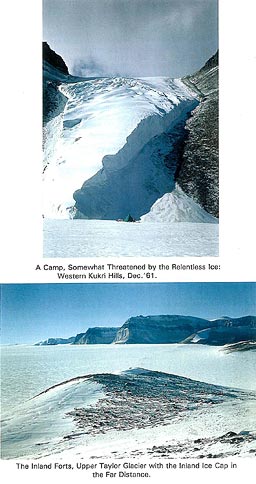 “Wilson!” I called. “Do you know what an oubliette is?”
“Wilson!” I called. “Do you know what an oubliette is?”
“Of course” said he, “we had one for a pet .... oh, I see, we’re in one, aren’t we?”
We had a quite tiny but quite effective radio and listened in to other parties, especially one up near Terra Nova Bay with some interest.
“We will be out of food by Monday,” came the calm Canadian tones of John Ricker.
“Repeat, Monday. M for Mukluk, O for a can of beans, N for Nansen, D for Dog “ This was the moment we sent our famous “Either feed Bogs to the Dogs, or a Dog to Bogs!” message, and lay around going “Hee, Hee, Hee, Ha, Ho, Ho, Ha,
Ha, Ha!” for an inconsiderable time. The Gods relented and a day or so later the Terra Nova Party got their resupply airlift.
After some work on the Kukri Hills we crossed the Ferrar and pushed on up the Emmanuel Glacier that flows down from Lister, highest peak of the Royal Society Range. Apart from Clements Markham at 15,000ft, Lister is the highest mountain in the whole Victoria Mountain chain or as some call them the TransAntarctic Mountains, the 18,000ft Vinson Massif being in a separate range. We camped below steep dolerite bluffs with the odd ice cascade falling over the lip a couple of thousand feet above. Once above this, the route lay over a rolling plateau of glare ice, but finally onto a nice snow patch below yet another sill. We took our light tent and packed up long crumbling ridges and then over interminable fields of snow, putting up the tent on the high plateau of deep snow. The next day we walked miles to the southeast, eventually reaching a steep face several thousand feet high. We put on our climbing boots but without overboots or any special gear our feet were soon freezing. We reached the crest of the north Ridge which can be seen from McMurdo at about ten thousand feet and pulled boots off to massage toes. My stupid frostbitten feet were giving trouble and Wilson nobly attempted to warm them but though they warmed the boots meanwhile froze like boards which meant that when I put them on again, my feet froze again.
However on the crest there was no deep snow and we warmed up. A hard, windswept ice ridge wound between rock and we cramponed on dourly, some cloud moved in from the southwest and still we pressed on finally reaching the summit of Lister at about 13,400ft sometime late in the evening. The East Ridge fell precipitously down towards the Snow Valley to the east and near its foot I could point out where Brooke and I had camped in the early Spring of ‘57. Fifty miles to the east the massive dome of Erebus rose almost as high and steamed quietly and off the tail of distant Hut Point Peninsula seventy miles away I fancied I could see a Hercules on the airstrip. Below, to the south were the summits of Hooker and Rucker, had we been mere peak baggers we might have traversed and claimed them all. Instead we built a small cairn on some nearby rocks, ate a little chocolate, patted Our Mountain on the topknot again and left for the long descent, down the summit ridge, along the flat north gable, down the ice-face and then wending miles over the undulating snow plateau back to the green Meade tent.
We paused for tea, struck camp and made some more miles over the undulating high snow, and three thousand feet down the rocky spur to the pyramid tent. Lister is somewhat taller than Cook and though technically easier, one has to walk a long way to reach her. Several hundred miles to the south near the Beardmore is Mt Markham which is about 15,000 ft high, but I do not believe it has been climbed to this day. Back in the pyramid we cooked a meal and rested, we had done all I needed to do and climbed Lister, Monarch of the Royal Society Range, to boot. I called McMurdo on the radio.
“Come and get us” I said.
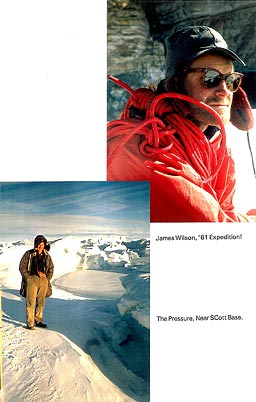 A day later a Sikorsky “Horse” windmilled in and we bundled our gear in and lifted off. A few hundred feet up a red light began flashing on the dash, the pilot swore and we autorotated back down landing rather heavily. The twin-row Pratt and Whitney engine has a rather clever device, all oil must pass through a single
A day later a Sikorsky “Horse” windmilled in and we bundled our gear in and lifted off. A few hundred feet up a red light began flashing on the dash, the pilot swore and we autorotated back down landing rather heavily. The twin-row Pratt and Whitney engine has a rather clever device, all oil must pass through a single
strainer and any metal in it causes the light to flash. We pulled the sump plug and out came pieces of metal two inches long, we had done a main bearing.
The pilot strode up and down swearing vigorously and, it seemed to me making a great todo about a piece of dumb machinery.
“That’s the third chopper we have lost in the last four days,” he said when I said as much. “One ran wild on the helipad, came apart and burned out, one was landing at Wright Valley and they got into an air-harmonic situation and she fell and burnt out. One of the ground party rushed into their tent and pumped a primus and it flared and burnt their tent, they were pretty cold when I rescued them. Now this. There is only one old machine left and it’s down at the Beardmore.”
“Oh, well, lets start walking.” I said carelessly, “Lets see, five days if we don’t sit around too much!”
He gave me a less than friendly look. “Let me try the radio”.
He did for the next half hour but VHF does not work from behind 13,000 ft. mountains. Wilson and I put up the pyramid again, brewed some tea, rigged our field radio and listened on medium wave, about 2350 kc.
“Generate Four calling !“ I said.
“Will you get to hell off the air ?“ said a plaintive voice. “This my sked. McMurdo, where the hell is our chopper? We were scheduled to be lifted out of Vanda three days ago, perfect flying weather, not a damn machine, just what the hell is going on …..”
“Sorry, we only have one machine left.” came back from McMurdo. “It is at present lifting a party out of the Ferrar. You will be next in a few hours. Hello Generate Four, come in please.”
“Hello McMurdo, this is Generate Four. Want to report a helo down in the Emmanuel Valley south of the Ferrar with shot main bearing. No possibility of flying again !“
“What? What ?“ cried the voice, from the Vanda party.”What the hell is this about a helo down?” “Get the hell off the air,” I said. “This is my sked!”
The pilot took over and had a long technical conversation with ground staff and then switched off and sighed. “Well, we might be picked up in two three days,” he said. “Or we walk! how much food do you have?”
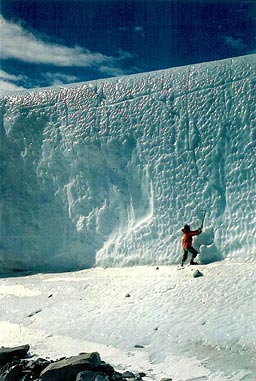 “Tons!” said I, “and we can always get a seal. Great stuff, seal liver, and a bit o’ blubber to chew on!”
“Tons!” said I, “and we can always get a seal. Great stuff, seal liver, and a bit o’ blubber to chew on!”
“Dogs, Wilson,” I said to James. “Dogs are the only sane and practical solution, the perfect symbiosis. If a dog dies, you feed him to the men, and if a man dies, you feed him to the dogs. Now what can we do with that useless heap of metal over there? Think of it, twenty point eight miles a day, absolutely guaranteed!”
However, two days later a rather battered old chopper appeared and lifted us out and a day or so after I saw it departing with a new engine in a cargo net heading for the Ferrar.
The next night at McMurdo was New Year’s Eve and a party was in progress.
“Our communications Chief wants to meet you,” said Phil Smith. “Why not come and see him now ?“ and I curiously followed, wondering what we had done wrong. A grizzled fiftyish man sat in front of a transmitter with a whisky bottle.
“Goddam it, Doctor Gunn,” he said, pumping my hand, “You are the only son-of-a-bitch, if you’ll pardon me, Sir, you are the only son-of-a-bitch in this whole Goddam dump who understands communications and I wanna shake your hand, yes Sir! Every Goddam sked you come up on schedule, you even give the weather you even know the procedures, Sir. Now them other sons-a-bitches I will goddam shoot, yes Sir!”
It seemed there were four other field parties out who had a remarkably cavalier attitude about keeping in touch. One party down near the Axel Heiberg, after several days of silence, were followed by an R4D plane which followed ski-doo trails pocked by broken crevasse lids and finally finding the party made a risky landing to find they had not called base because “we were too busy! Anyway, there was nothing to say!”.
We still had a few days and I went to the USARP HQ. “I wanna go to the Pole!” I said. They looked uncomfortable.
“So does everyone” they said. “And they all have the craziest reasons. And it costs an arm and a leg. Why do you want to?”
“Just curiosity” I said. “Damn it, I’ve been here for years, I’ve damn-well sledged more miles than enough, see that street down there, well, I located it for you, see that map on your wall, well we made it, come on!” The atmosphere had changed over the years, no longer were people nice to me because I was a naive country boy, I was an O.A.E. and even civilians addressed me as “Professor “ (which I was not at the time), or as “Doctor Gunn” or “Sir”. Sometimes I missed Hank Jorda and his “Hey, there, Bernie Boy!”
“Let’s see The Admiral!” they said.
“Goddam it, Doctor Gunn”, said The Admiral. “Of course you should Goddam go. See to it, Smith!”
I went in on a routine flight in a “Herky-Bird” following the same ground we covered with Rudy and Hank and Jack Donovan in ‘56. I even saw the evil broken area off the Barne where Couzens died. At the Beardmore we turned and flew up it, past the Cloud maker and Mt Kyffin. I spoke to the Navigator who was plotting on a grid.
“Where are we ?“
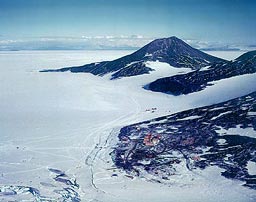 “I don’t really know, Sir,” he said. “That cross is McMurdo, that one is the Pole. We use a grid because the longitude lines are so close together, we are three hundred miles from the Pole about.”
“I don’t really know, Sir,” he said. “That cross is McMurdo, that one is the Pole. We use a grid because the longitude lines are so close together, we are three hundred miles from the Pole about.”
“We’re right over Buckley’s Island!” I said. “See the Mill Glacier?”
“Oh, are we?” and he made another mark.
We droned on, on automatic pilot. “Take my seat if you want pictures” said the Chief pilot,” it has the best view. Just don’t touch that button, it switches off the automatic pilot! I’m going aft!” The Co-pilot dozed on with his feet on the dash. The Chief Pilot’s seat did command a wonderful view with windows down to the floor on my left looking out to the Grosvenor Range.
It was only minutes later a hellish clatter broke out, engines speeded up or stopped and we did a wing over and headed straight down at about 400 knots. It is especially startling in a large machine which flies normally steady as a rock.
Seldom have men come awake so fast as the co-pilot and the engineer.
“Which one, which one?” cried the pilot
“Number two!” called the engineer and the pilot feathered a prop, slammed a throttle shut and eased the nose up. It seemed the electrical generator shaft had sheared and we had lost power, motor synchronisation, the automatic pilot and all else. We simply switched to the other generator and flew on on three engines at 320 knots.
The Pole lies in a featureless high plain of snow ribbed by sastrugi, no different to the Plateau elsewhere, a few flags and a graded strip marked the Pole Base and a ring of fuel drums and a flag, the actual Pole.
“We won’t be on the ground long” warned the Crew Chief, “Just as soon as we dump these drums we leave!” I set off for the Pole flag at a run clutching a camera. This soon slowed to a walk, running at 10,000ft without acclimatization is not on. It was about 40 below and my iceaxe squeaked in the gritty snow. I took a couple of shots, there was a shattering roar, the distant Herc began to move, took off and vanished into the blue and there I was quite, quite alone, ten yards from the South Pole!
Reason returned, there was supposed to be a base here somewhere even though nothing was visible, all I had to do was move in ever increasing latitudinal circles to find it. Which way? Well every direction is north so, north it was. I headed towards Tahiti. After a quarter mile of squeaky sastrugi I came to vehicle tracks and a ramp going down into the bowels of Hades and in some trepidation, walked down. There were insulated huts with a covered way in between, with rows of stacked empty fuel drums supporting a timber, netting and burlap tunnel roof. The drums were crushed and buckling under the weight of snow. I came to a door marked “Mess Hall” which looked promising. I pushed open a door and saw a youngish bearded man at a stove slapping out apple pies. He glanced up unsurprised.
“Hello” he said, “You’re new. Are you just off a traverse? Have a coffee and apple pie!”
“I just got left behind,” I explained, biting into a very fine apple pie indeed.
I spent an interesting two or three days at the Pole. There were about twenty men there, still doing IGY-type recording of atmospherics, ionisation layers, radio-propagation and ionosonde work but it seemed that no money was available for any of this massive amount of data to be correlated. I later wrote a story saying that if science was the only justification for keeping open the Pole Station, then it should be closed and the bureaucrats had not forgotten this threat to their existence twenty years later. The Base leader was a young doctor and in typical American fashion, they made no fuss, made me welcome, were extraordinarily kind and said no harsh words about my stupidity in getting myself left. I flew out on another Hercules fuelling flight. I think at that point they still had one of our old T.A.E. Ferguson tractors in use at the Pole Station.
Back in McMurdo, Wilson and I walked over to Scott Base, some of our friends were backfrom Terra Nova Bay, people like Bogs Sheehan, and Frank Graveson were around, a few people with the old spirit like that best of Canadians, John Ricker. There were still a handful of dogs on the dog lines, neglected and with blubber-matted fur.
“I knew your father, lad,” I said patting one who looked like Fido. “And maybe your Grandfather too!”
They were experimenting with Ski-doos and I took one for a run round the pressure. There was no exhilarating scamper, no waving tails, it rattled and roared and jolted along and within ten minutes I was cold and bored silly.
“They’ll never catch on!” I said to Wilson, not perhaps one of my best prophesies, for all I have a Pictish ancestress.
A few days later I was back in New Zealand and was soon off to Canberra to begin two years work analyzing dolerites and learning to use electron microprobes, X-Ray fluorescence spectrometers, mass spectrometers and all those tools of the modern scientist. The National Science Foundation gave me an American salary and for the first time in my life it was not a continual problem of where the next meal might come from. I was never to drive a dog team again and they have vanished from the earth as a serious form of transport. Like the caleche, the troika, the Hansom, and Cobb and Co, they have become another figment of history books and our colourful past.
©2007 - may not be reproduced without permission